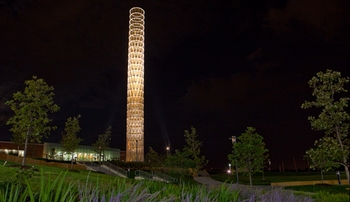The “Hope Tower” in the Ruth and Bill Scott Student Plaza at UNMC is one of five artworks cited by a leading architectural firm as an example of how iconic artworks can be integrated into building sites.
The firm of Skidmore, Owings & Merrill LLP (SOM) is one of the largest and most influential architecture, interior design, engineering, and urban planning firms in the world. Founded in 1936, the company has completed more than 10,000 projects in more than 50 countries. SOM is renowned for its iconic buildings and commitment to design excellence, innovation, and sustainability.
Created by James Carpenter Design Associates of New York City, the Hope Tower was completed in 2011. SOM collaborated with Carpenter on the Hope Tower and a number of other projects to enhance the experience of architecture with Carpenter’s distinctive, light-based installations.
The 120-foot tower was cited by SOM for the way it “plays off of the dramatic natural qualities of the Nebraska sky and reflects the school’s scientific character.”
SOM engineers worked closely with Carpenter to address wind forces, which could cause the slender tower to sway. The design features hundreds of perforated, triangular panels of titanium-coated stainless steel, fitted into a diagrid frame.
After numerous geometric studies to account for sway, weight, and gravity, the design team increased the number of perforations in the tower’s paneled skin proportional to its height. This created a structure that is more than three times as porous at its apex than its base, which increases its overall stability.
SOM’s work on the structure allowed Carpenter to focus on the tower’s relationship to light. The steel panels are designed to reflect sunlight and atmosphere at different times of the day; by night, internal illumination transforms the tower into a lantern.
Since its installation, Hope Tower has become a beacon on the campus and a gathering place for students, faculty, and visitors alike, according to SOM.
